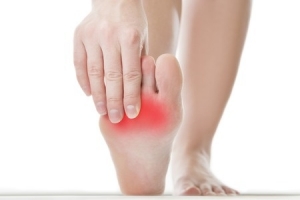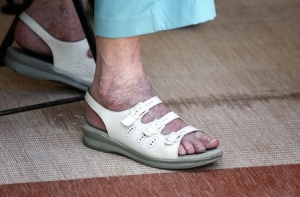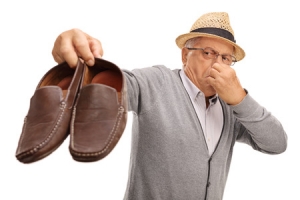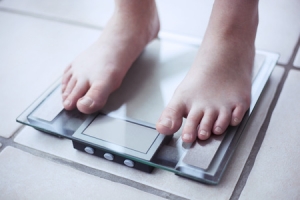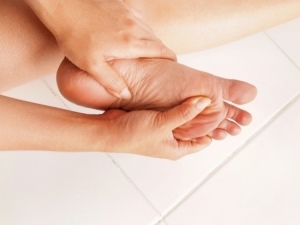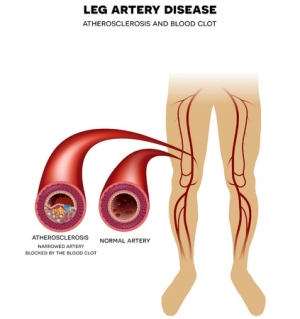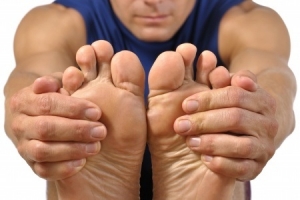Connect With Us
Blogs
Excess Pressure Can Be a Pain in the Foot
Our feet are pretty forgiving. They take us where we need to go and help us stay fit by enabling us to participate in sports and exercise activities. They even accept being crammed into uncomfortable shoes now and then for the sake of fashion. However, we can push it too far. When an excessive amount of pressure is put on our feet we are susceptible to many foot disorders. One of them is metatarsalgia. This condition’s telltale sign is pain in the ball of the foot where the five long metatarsal bones end. At Superior Foot & Ankle Care Center we find that there are many ways that patients put too much pressure or uneven pressure on this part of the foot, including:
- Standing or walking for long periods of time on very hard floors or ground
- Frequently participating in weight-bearing activities such as running, dancing or basketball
- Wearing shoes that fit improperly or spending too much time in shoes with very rigid soles such as work boots or hiking shoes
- Gaining weight
Sometimes, metatarsalgia is caused by conditions that are beyond a patient’s control such as arthritis, flatfeet (overpronation), an injury or foot deformity. This condition is also more likely to occur with age as the fat pads on the bottom of our feet naturally begin to wear down.
Treating Metatarsalgia
If our podiatrists, Dr. Victoria Foley and Dr. Constance Omelas, diagnose metatarsalgia the first step will be to reduce the pain and discomfort that you are experiencing. This can usually be accomplished with rest, icing and anti-inflammatory medications. The next step will be to deal with the root cause of the condition. Depending on what the source of foot pressure is, the foot doctor may recommend changing the types of shoes you wear, losing weight, treating an existing condition or using a custom orthotic device to alleviate inflammation to the affected area.
Be good to your feet by not waiting to seek medical treatment if you are experiencing pain, discomfort or other unusual symptoms. Contact our Long Beach office for an appointment by calling: (562) 420-9800.
Varicose Veins and Foot Health
Many patients think that varicose veins are just a cosmetic issue but at Superior Foot & Ankle Care Center we know that they can be much more serious. The twisted and swollen veins that appear dark bluish in color occur when the valves inside the veins become stretched or weakened and blood pools in the veins which causes them to become enlarged. These veins are more likely to appear in your feet and lower legs because these veins are farthest from the heart and have to do the most work fighting against gravity to get the blood back to your heart. Varicose veins can be very painful and may also indicate a circulation issue. That’s why it’s important to have your varicose veins evaluated.
Treatment and Prevention
Our podiatrists, Dr. Victoria Foley and Dr. Constance Omelas will do a complete examination of your feet and lower legs and will want to get a medical history as well as information about your current lifestyle. If you have a history of blood clots or have had an injury to your leg, for example, you have a higher risk for varicose veins. For most patients, the risk of varicose veins increases with age and also if you are overweight and are not very active.
The treatment for varicose veins will depend on the cause and the severity of the discomfort you are experiencing. In many cases, losing weight and exercise can help reduced symptoms or prevent pain. The foot doctor may also suggest that you wear compression stockings, elevate your feet for some time each day and avoid long periods of standing or sitting. There are also surgical treatment options available.
If you have varicose veins, regardless of whether they are painful or not, make an appointment at our Long Beach office by calling: (562) 420-9800 and to discuss the best options for caring for them.
What’s Behind Ingrown Toenails?
Ingrown toenails (officially known as onychocryptosis), a condition we see frequently at Superior Foot & Ankle Center, are painful and potentially can lead to an infection. They occur when the side of a nail begins to grow back into the skin and are seen most often on the big toe. As the nail becomes ingrown the skin around it usually becomes inflamed, red, warm and very tender to the touch. Once the nail actually breaks through the skin, bacteria have an entry point and an infection may occur.
Causes
There are several factors that can make an ingrown nail more likely. Some are preventable but others are not. Common causes include:
- Poor nail trimming—this is the most common reason ingrown nails develop. If nails are shaped so that they curve on the sides or if they are trimmed too short, the skin may fold over the corner of the nail and the nail will begin to grow inward.
- Heredity—for some people ingrown nails are a genetic tendency.
- Shoes and socks that don’t fit—if you wear footwear that is too tight or spend a considerable amount of time in high heels that force all your toes together in the front of the shoe, the pressure may push the nail into the skin.
- Overuse or trauma—patients who run or play sports that involve frequent kicking are more likely to develop ingrown toenails. Dropping a heavy object on your toe or severely stubbing it can also be a catalyst.
- Nail problems—a fungal or bacterial infection or nail deformity can be a cause.
Treatment
If you have an ingrown toenail that soaking in warm water isn’t releasing, contact our Long Beach office by calling: (562) 420-9800 and let our podiatrists, Dr. Victoria Foley and Dr. Constance Omelas help you eliminate this painful condition. Don’t attempt “bathroom surgery” on an ingrown nail! Notching, sticking cotton under the nail and other “home remedies” not only are ineffective, but they can result in a more serious injury and infection.
Foot Health and Pregnancy
At Superior Foot & Ankle Care Center pregnant women will often come to our Long Beach office with foot concerns that they didn’t expect. Pregnancy changes your body in various and dramatic ways and your feet are not left out of the fun! Here are some foot and ankle conditions you may experience during the course of your pregnancy:
Ankle Turns/Sprains—to prepare your body for pregnancy and the passage of a baby through the birth canal hormones are released which help ligaments relax. Since these hormones cause all the ligaments in your body to relax you may find your ankle giving way more readily. This issue is made worse by the shifting of your center of gravity as the baby grows.
Swollen Feet and Ankles—retaining water is a normal (if uncomfortable) part of pregnancy. This extra fluid tends to accumulate in your feet and ankles. This can make feet feel sore and tired. Cut back on salt, drink plenty of fluids and be sure to elevate your feet for some time every day to help combat the swelling.
Foot pain—excess weight, even though temporary, can cause pain in the arch of your foot and even cause flatfeet. Heel pain is also common. Be sure to wear shoes that have extra cushioning and shock absorbing soles. Look for styles that provide good arch and ankle support as well.
Pregnancy can also exacerbate existing foot conditions, particularly those affected by weight or involving inflammation. Our podiatrists, Dr. Victoria Foley and Dr. Constance Omelas will evaluate your feet and ankles and help you find ways to keep existing problems in check. They will also discuss ways to prevent the other podiatric problems that pregnancy can bring and offer safe suggestions for relief of any foot pain or discomfort you encounter. Contact us for an appointment by calling: (562) 420-9800.
5 Ways to Help Feet Smell Sweet
If you have smelly feet, you know it’s not a joking matter. At Superior Foot & Ankle Care Center we know that foot odor is embarrassing and it can also be a sign of a medical condition. People with sweaty feet often have a foot odor problem. It’s not the sweat, however, that smells bad, it’s when the sweat mixes with bacteria present in your socks and shoes that the foul smell occurs. Here are some ways that you can try to eliminate foul foot odor:
- Practice good podiatric hygiene. This means washing feet daily with warm water and a mild soap. (Be sure to dry completely, especially between your toes to prevent athlete’s foot from developing.) If you tend to sweat excessively, applying a talcum or anti-fungal foot powder may also be helpful.
- Wear cotton socks or those made of a natural material that wicks the sweat away from your skin rather than traps it. Ditto for your shoe choices. Plastic shoes and nylon socks do not encourage air circulation which is essential for preventing stinky feet.
- Change socks daily and more than once a day if your feet get wet or become sweaty.
- Don’t wear the same shoes two days in a row. Allow at least 24 hours for shoes to air out between wearings.
- Do not share socks, flip flops, pedicure tools, wash cloths or anything else that touches someone else’s feet directly—this is how bacterial and fungal infections are spread.
If these steps fail to get rid of foot odor, make an appointment at our Long Beach office. Our podiatrists, Dr. Victoria Foley and Dr. Constance Omelas will examine your feet and look into your medical history. Once the source of the foot odor is determined the foot doctor will prescribe the correct treatment to eliminate it and get your feet smelling sweet again.
What You Eat Matters to Your Feet
Did you know that a significant number of foot and ankle conditions are caused or made worse by being overweight? Plantar fasciitis, arthritis, flatfeet, tendonitis and stress fractures all have excess weight as a risk factor. In addition, carrying more pounds than you should can affect your knees, hips and back which can then lead to secondary foot problems due to changes in your gait to compensate for pain in these other parts of your body. Lastly, overweight patients are more likely to develop high blood pressure, heart disease and diabetes—all of which pose serious medical threat to your feet (not to mention the rest of your body). March is National Nutrition Month and here at Superior Foot & Ankle Care Center we would like to offer these tips to improve your diet and attain or maintain a healthy weight:
- Let’s eat in—cooking meals at home puts you at a nutritional advantage. You can control the ingredients and calories in the dishes you prepare. Good food doesn’t have to be complicated. Learn some simple dishes and up the flavor quotient with herbs, spices and citrus fruits instead of fats and creamy sauces. Choose broiling or grilling over frying as your cooking method.
- Portions matter—how much you eat is almost as important as what you eat. Ask your doctor what amount of calories you should be consuming everyday to maintain a healthy weight. Check the serving sizes in the nutrition facts for the foods you eat and adjust to your daily intake if necessary. Try using a smaller plate to automatically scale back on portions.
- Variety is the spice of life—mix up your menus. Be sure to include a colorful array of different fruits and vegetables each week. By doing so, you’ll go a long way toward ensuring that you are getting all the different nutrients you need. Explore food from different cultures.
- Add some action—try to be physically active for some part of every day. This doesn’t mean you have to go to the gym or play on a team. Take the stairs, pull weeds, walk while you talk on the phone in your office—just get moving. This will help burn calories and increase fitness. Exercise can also help fight heart and other disease.
Our podiatrists, Dr. Victoria Foley and Dr. Constance Omelas, believe in a total body approach to good health. If you have questions about your weight and your feet or are experiencing pain or discomfort in your feet currently, contact our Long Beach office for an appointment.
How to Select the Proper Shoe for Running and Walking
When it comes to running or walking for exercise, we at Superior Foot & Ankle Center believe that the most important piece of equipment required is a good shoe that is properly fitted for your individual foot. You do not need different shoes for running and walking. Running shoes usually have more shock absorption and are fine for walking.
Below are some tips to help you choose the right shoe and get a good fit:
- Start with an appointment with one of our podiatrists, Dr. Victoria Foley or Dr. Constance Ornelas. The right shoe for you will depend on your foot type. If you have a high arch or you wear a custom orthotic device, a cushioned neutral shoe is best. For someone with flat feet, a stability shoe is recommended. See our approved shoe list for specific brands and styles. Your foot doctor can make suggestions for particular styles or features if you have a toe deformity or other foot or ankle condition that will help protect the area and make running or walking more comfortable.
- Get professionally fitted by a sports shoe expert. Most people have two different size feet. It’s essential to buy shoes to accommodate the larger foot. There should be a half-inch of space between your longest toe and the front of your shoe. A majority of people wear shoes that are too small for their feet and this leads to injury and deformity.
- Wear the socks you will run or walk in when you go to try on shoes. We recommend a cotton blend or a sock with CoolMax. Bleach white socks to prevent athlete’s foot.
- To avoid blisters, be sure that the heel of the shoe fits snugly and that the foot doesn’t slip when you walk. Also, run your hand around the inside of the shoe to check for rough stitching or bumps that can cause friction and result in a blister.
- Take your time when trying on shoes. Walk around the store for several minutes. Many running shoe stores will have a treadmill so that you can try running in the shoes as well.
- Remember to replace running/walking shoes after approximately 400 miles. Even good shoes lose their supportiveness once they are worn out and wearing them can present an increased risk of injury.
If you have more questions about running or walking and your feet, contact our Long Beach office by calling us at 562-420-9800.
Why Do My Feet Feel Like They’re On Fire?
One of the complaints that patients sometimes bring to Superior Foot & Ankle Care Center is a burning sensation in their feet. In addition to examining your feet, our podiatrists, Dr. Victoria Foley and Dr. Constance Omelas will want to get a complete medical history. If you are over the age of 50, a burning feeling in your feet is more common, especially if you’ve walked a long distance or spent many hours standing. The foot doctor may suggest some ways to relieve the burning, such as:
- Not standing for long periods of time or, if you have a day where you need to be on your feet, at least take breaks and put your feet up for a few minutes every hour
- Make sure your shoes fit properly and are not too snug; the design of the shoe should allow for air circulation
- Choose breathable materials for shoe and socks—synthetics can prohibit feet from breathing and make burning more likely
- Try cushioned insoles for increased comfort
- Soak tired feet in a foot bath to relieve burning
A Word of Caution
Sometimes a burning sensation in your feet may be the result of a more serious podiatric problem. For example, a structural problem may require an orthotic device to shift pressure away from the troubled area and alleviate the burning. Other possibly serious reasons for burning feet include:
- A Neuroma or Tarsal Tunnel Syndrome
- Diabetes
- Thyroid Disorder
- Obesity
- Alcohol Abuse
If burning feet is a problem that you endure consistently, you should make an appointment to get your feet evaluated at our Long Beach office. Many times your feet can be an early warning system for systemic problems in your body and it’s better to be safe than sorry. Contact us at 562-420-9800 and find out what’s behind your burning feet.
You’ve Got to Have Heart and Sole
February is National Heart Month and here at Superior Foot & Ankle Center we want patients to understand the vital connection between heart and podiatric health. High blood pressure, or hypertension, is a major contributing factor to heart disease. Hypertension can lead to peripheral artery disease and other circulation problems which can have a significant impact on your feet. Poor circulation, particularly in patients with diabetes can lead to sores and ulcers forming on your feet and increase the risk of amputation. Here are some other facts about hypertension:
- 90 percent of American adults are expected to develop high blood pressure during their lifetimes
- It’s the number one risk factor in women’s deaths in the U.S. and the number two for men
- High blood pressure is more prevalent in blacks than whites and also develops earlier in life
Fight Back
There are a number of ways that you can help reduce your risk of hypertension:
- Know your numbers—get your blood pressure checked regularly
- Maintain a healthy weight—add more colorful fruits and vegetables to your plate, reduce carbs and sugars
- Exercise regularly—look for small ways to increase activity: park farther away from your office entrance, pace while you talk on the phone
- Reduce sodium in your diet—read labels and make more meals at home using herbs, non-sodium seasonings, citrus fruits and other flavorful ingredients to spice up your dishes
- Limit alcohol intake
- Don’t smoke
- If your doctor prescribes medication for hypertension take as directed
If you have not been diagnosed with hypertension but you are experiencing cramping in your feet or changes in feet’s skin color or temperature, make an appointment at our Long Beach office by calling: to see one of our podiatrists, Dr. Victoria M. Foley or Dr. Constance Ornelas. These may be early warning signs of high blood pressure or another condition that the foot doctor will want to evaluate.
Questions about Hammertoe
One thing just about everyone knows about hammertoe is how to recognize it. The telltale downward bend of the toe in the shape of a hammer make it an obvious deformity to spot. At Superior Foot & Ankle Care Center we have found that beyond its appearance, many patients don’t have all the facts about this condition. Below are some common questions and answers about hammertoe:
- What’s the cause of hammertoe? This condition is often the result of a muscle imbalance but can be exacerbated by wearing shoes that don’t fit well or styles that have narrow toe boxes or force the foot into the front of the shoe, like high heels. Other possible factors in a hammertoe forming are genetics and arthritis.
- Which toes are affected? The second, third and fourth toe are usually the ones affected by this condition.
- Is all the pain and discomfort in the joint? No. While the abnormal position of the toe does cause inflammation, pain and discomfort, corns often form on the top of the toe due to the friction of rubbing on shoes and calluses may develop in the ball of the foot from the excessive pressure caused by the bent toe.
- How are hammertoes treated? Treatment of hammertoe is multi-dimensional. Our podiatrists, Dr. Victoria Foley and Dr. Constance Omelas will want to perform a complete examination of your toes and feet, which may include x-rays. If you are experiencing a fair amount of pain, anti-inflammatory medications and cortisone injections may be recommended to reduce the pain and inflammation. To correct the hammertoe, custom orthotics and/or splinting and taping the affected toe may be an option. Physical therapy and exercise can help stretch and strengthen the toe.
- Will hammertoe go away without treatment? Hammertoe is a progressive condition. In fact, if left untreated, the toe will become increasingly rigid in its bent position and eventually will only be correctable with surgery.
If you have noticed any signs of hammertoe, the sooner you get it evaluated the less intense and more successful non-surgical treatment is likely to be. Contact our Long Beach office for an appointment by calling: 562-420-9800.
